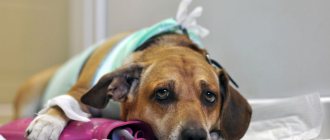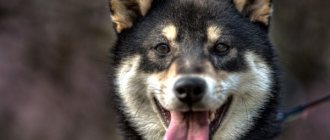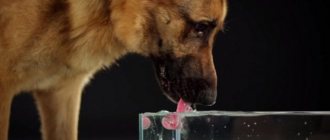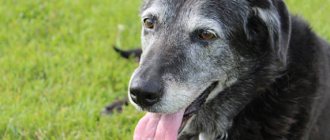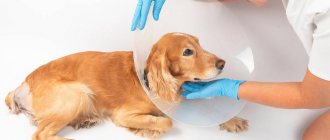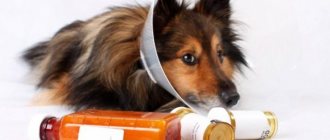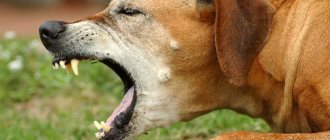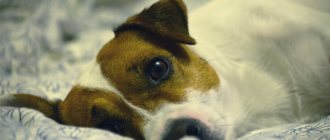How should a healthy dog breathe?
Let's figure out how a healthy dog should breathe. The breathing rate depends on the size of the dog; the larger the size, the fewer breaths it takes per minute. The respiratory rate is measured by recording the movements (raising) of the ribs.
For large dogs, 12-18 lifts per minute is considered normal. Small dogs breathe more quickly, approximately 18–24 breaths per minute. Both the frequency and depth of inspiration are recorded. If, when a dog inhales, the peritoneum, and not the chest, enlarges, this is a symptom of a dysfunction of the respiratory system. In addition, the respiratory rate is measured in conjunction with the pulse.
If you think your dog has heatstroke, here's what to do to help:
- Move the dog inside or to a shady area.
- Immerse her in cool water (avoid cold water, which constricts blood vessels) or cold towels to the chest, neck and head. Don't spray your dog with a garden hose—on hot days, the water inside the hose can reach close to boiling temperatures. They need to cool gradually.
- Give your dog cool, not cold, water. Or let them lick ice cubes.
- Once you have started cooling your dog, take him to the vet immediately.
The best way to deal with heatstroke is to avoid it. Never leave your pet in a parked car. It is better to leave your pet at home rather than risk heatstroke. At home, be sure to provide all pets with shade and water or access during the hottest part of the day.
The main causes of rapid breathing in dogs
The main causes of rapid breathing in dogs can be associated with both internal and external factors. Internal, physiological factors include:
- Any ailments that affect body temperature and metabolism.
- Stress and emotions.
External factors include:
- Air temperature and humidity.
- Atmosphere pressure.
- The situation.
The factors that can cause breathing problems are very extensive, so they need to be considered in more detail.
Additional symptoms of rapid breathing in dogs and their explanation
You can assume that your dog is sick or suffering from stress only if you know the additional symptoms of rapid breathing in dogs and their explanation. If you realize that something is wrong with your dog, but cannot identify additional symptoms, it is best to consult a veterinarian.
The dog breathes frequently with its mouth open
If your dog is breathing frequently with his mouth open, this may be a sign of:
- Choking.
- Fevers.
- Feeling hot.
When a dog suffocates, the mucous membranes turn pale. Fever is determined by measuring body temperature. When a dog is hot, it breathes with its mouth open to cool itself.
The dog often breathes with its mouth closed through its nose
When a dog frequently breathes with its mouth closed through its nose, the reason for the strange behavior may be:
- Stress.
- Pain syndrome.
- Fatigue.
When a dog is stressed, its heart rate and breathing rate increase. The dog may worry for its own reasons or react to the external situation. Intense breathing through the nose may indicate slight hypoxia, which occurs due to overwork. Overfatigue can occur both after heavy physical exertion and when it is impossible to thrust deeply.
While in pain, which the pet may be enduring, the dog may not show any signs other than heavy breathing. It is important to understand that the source of pain can be anywhere; it can be found by palpation and close observation of the pet.
The dog is shaking and trembling
If your dog is panting, shaking and trembling, the reasons may be:
- Fright.
- Heatstroke or increased body temperature.
- Strong pain.
- Neurological disorders.
The dog may tremble when experiencing strong emotions. Most often, trembling occurs due to fear. Heatstroke and fever cause the blood to thicken. Tremor in this case is a natural reaction of the body associated with an attempt to push clotted blood through narrowed vessels.
With unbearable pain, in addition to tremors and rapid breathing, you can observe apathy and even aggression in the dog. The most difficult thing to diagnose is tremor due to a neurological disorder. Trembling can be a sign of either an indolent neurological disease or a seizure.
A dog breathes with its tongue hanging out in the not hot season
If a dog breathes with its tongue hanging out during a non-hot season, there may be several reasons:
- Increased body temperature.
- Strong emotions or stress.
- Violation of water-salt metabolism.
The amount of saliva secreted directly depends on the water-salt and electrolyte-water balances in the body. The balance of these balances is influenced by the microelements that the dog receives from food. When these balances are disturbed, the dog produces a lot of saliva. In this case, saliva may drip from the muzzle or the dog may pant with its tongue hanging out to dry its mouth.
Note! Breathing with your mouth open and your tongue hanging out is a sign that labor is approaching.
The dog breathes frequently in its sleep
If a dog breathes frequently in its sleep, the reasons may lie in both physiological and emotional aspects. Science has proven that dogs, like people, can see realistic dreams and experience strong emotions, as a result of which the pulse and breathing rate increase.
Increased breathing during sleep can occur due to diseases of the cardiovascular and respiratory systems. In addition, if a dog sleeps in an awkward position, its upper palate may recede, which causes both snoring and rapid breathing.
The dog drinks a lot of water
When a dog breathes frequently and drinks a lot of water, there may be several reasons:
- Hot weather.
- Acute pain due to the inflammatory process.
- A disorder of the hormonal system, most often diabetes.
If the amount of water consumed suddenly increases and this change is not associated with an increase in air temperature, contact your veterinarian immediately. Polydipsia is a symptom of various, including chronic and fatal diseases.
Pet has a hot nose
When your pet has a hot nose and rapid breathing, there are two possible reasons:
- The dog recently woke up.
- The pet's body temperature has risen.
Tip: If you suspect your dog has an elevated body temperature, do not rely on tactile sensations. A hot nose, ears and mucous membranes are not a guarantee of fever.
The dog is restless and does not find a place for itself
If you observe that the dog is breathing frequently, restless and does not find a place for itself, the reasons may be as follows:
- A sharp deterioration in health.
- Longing for the owner or family member.
- Stress that the dog is experiencing or has recently experienced.
It is important to remember that anxiety and too fussy behavior can be a sign of dangerous neurological diseases. The clinical picture needs to be assessed comprehensively, and if you doubt your own knowledge, it is better to consult a veterinarian.
Lethargic, walks slowly or does not get up at all
Rapid, shallow breathing, if the dog is lethargic, walks slowly or does not get up at all, indicates a critical loss of strength. This condition can occur due to:
- Progression of a chronic or viral disease.
- Anemia.
- Severe stress.
- Injuries.
- Recently undergone anesthesia.
- Aggressive treatment.
- Poisoning.
- Volvulus.
- Failure of the cardiovascular system.
Important! If the dog is so weak that it cannot stand up, diagnosis and treatment at home is unacceptable.
Coughs or wheezes
If your dog is panting, coughing, or wheezing frequently, the reasons may include:
- Reverse sneezing.
- Recession of the upper palate.
- Entry of a foreign object into the respiratory tract.
Reverse sneezing and sunken palate cause similar conditions in which the dog inhales with a loud, forceful wheeze. This condition is not life-threatening, but it looks scary. To help your pet cope with an attack, you need to calm him down, sit him down and actively stroke his neck (from the throat side).
If a foreign object enters the respiratory tract, there is a serious risk of suffocation, so it is necessary to quickly inspect the mouth and, if possible, remove the foreign object. If the foreign object is too deep in the throat, the dog should be calmed to breathe through its nose and taken to a veterinarian immediately.
Tongue color red
If your dog's tongue is red and there is rapid breathing, the most likely cause is a sudden increase in blood pressure or fever. First of all, you need to exclude an increase in body temperature. If the body temperature is normal, the dog should be calmed as much as possible and taken to a veterinarian.
Attacks of sudden increases or decreases in blood pressure can be deadly because they have a detrimental effect on the heart muscle. It is important to remember that surges in blood pressure are a symptom, so treating them without determining the root cause is useless.
What does it mean if a dog has a blue tongue?
Rapid breathing and a blue tongue indicate hypoxia and oxygen starvation. May occur due to:
- Poisoning.
- Neurological disorder.
- Neck or throat injuries.
- Collapse of the lungs or trachea.
- Entry of a foreign object into the respiratory tract.
If a dog has been poisoned and is already experiencing hypoxia, its body temperature will be lowered. Neurological disorders are always accompanied by additional symptoms, for example, unsteady gait, inability to focus, lack of response to external stimuli, etc.
Injury to the neck and throat can occur due to fights, blows, improper use of the collar, etc. Collapse of the lungs or trachea are two deadly, pathological conditions that are almost impossible to stop at home.
The animal is breathing heavily, as if it is suffocating
What does it mean if an animal is breathing heavily, as if it is suffocating? In such an acute condition, the cause is not as important as prompt assistance. The only exception is suffocation due to a foreign object entering the respiratory tract. In this case, the condition can be stopped only by clearing the airways.
If the cause of choking cannot be determined, the dog needs to be laid on its side, calmed down, and ensure that its tongue does not stick out. If necessary, hold the mouth open with your hands or a spacer. Take your dog to the vet immediately as hypoxia can cause permanent brain damage.
The dog stretches its neck and head
When a dog is choking, it spreads its front legs wide, stretches its neck and head, opens its mouth and greedily swallows air. Most often, this condition is associated with injury, panic attacks, or a foreign object entering the respiratory tract.
Be attentive and careful, if the dog is choking, it can show aggression even to the owner. Talk to your pet constantly, but do not try to change his body posture or lead him somewhere. To deliver the patient to the veterinarian, he must be carried in his arms.
Drooling
If your dog is breathing frequently and drooling, the reasons may be:
- Severe stress or emotions.
- Poisoning.
- Toothache.
- Entry of a foreign object into the respiratory tract.
Dental diseases, and especially acute pain, are not always able to be detected even during an examination in a clinic. An acute painful reaction can manifest itself reflexively or be hidden by the dog for a long time. The only way to make sure that your dog has healthy teeth is with x-rays.
Heat stroke or poisoning
It is normal for a dog to pant or pant after exercise. And some breeds, such as Boston terriers, bulldogs and pugs, are prone to panting more heavily than others because of their short muzzles.
However, heavy breathing is also a sign that the dog may be suffering from heatstroke or may have ingested a toxic substance.
If you can't find an obvious reason for your dog's sudden change in breathing, contact your veterinarian immediately.
If you suspect heatstroke, first follow the steps at the end of this article to safely cool your dog down.
Factors that cause rapid breathing in dogs
There are many reasons for a dog’s rapid breathing, and it is simply unrealistic to foresee all possible problems.
In order to prepare for possible problems, we will describe the most popular factors that provoke rapid breathing in dogs.
Breed predisposition
Rapid breathing may occur due to a breed predisposition. People who are prone to rapid breathing are:
- Miniature and small breeds.
- Brachycephals.
- Large dogs in old age.
Small dogs breathe more frequently due to their faster metabolism and increased heart rate. Brachycephals are prone to a number of problems because their skulls are unnaturally shaped. Many brachycephalics experience softening of the upper palate. Large dogs in old age often suffer from pathologies of the cardiovascular system.
Rapid breathing during pregnancy
Frequent breathing during pregnancy is expected:
- In hot weather.
- After physical activity.
- In the second half of pregnancy.
- On the eve of childbirth.
From the moment of conception to childbirth, the expectant mother's body is constantly being rebuilt, which can lead to the appearance of unexpected symptoms. Naturally, a pregnant dog needs to be protected from stress and excessive stress. In the second half of pregnancy, in order to make life easier for the pet, she needs to be switched to fractional feeding.
In nursing dogs, after birth
During childbirth, the dog's rapid breathing occurs due to stress and severe pain. Immediately after the birth of the puppies, the condition of the young mother should return to normal. Rapid breathing in nursing dogs after birth, especially in the first two days, is a symptom of postpartum preeclampsia. Eclampsia is considered a life-threatening and rapidly progressive condition.
Frequent breathing after childbirth may indicate pain if the birth ended prematurely. Quite often, incomplete expulsion of the litter or placenta is observed if the birth was difficult and led to loss of strength.
After surgery and anesthesia
Rapid breathing immediately after surgery and anesthesia is not the norm. Anesthesia is used in combination with sedatives, which guarantees a calm state of the dog in the first few hours after surgery. If the dog is breathing heavily, shallowly and intermittently while recovering from anesthesia, this is a sure sign of complications that have affected the functioning of the cardiovascular system.
After recovery from anesthesia, rapid breathing may indicate severe pain. Surgery, even the simplest one, must be accompanied by postoperative therapy. After surgery, dogs are prescribed painkillers and anti-inflammatory drugs; if the intervention was open, antibiotics are used for prophylaxis.
After meal
Frequent breathing after eating may indicate:
- Haste.
- Binge eating.
- Powerful emotions.
Determining the cause of rapid breathing directly depends on the dog's temperament. If you notice that your dog is eating too quickly, try feeding him from a special bowl with a structured bottom. Overeating causes distension of the stomach and physical pressure on the diaphragm, leading to increased breathing.
When traveling in a car
A dog's rapid breathing when riding in a car is a natural consequence of stress. Even if your pet loves to ride in a car and is used to this procedure, he will be worried because the trajectory of movement is not under his control.
When traveling in a car, dogs often get motion sickness, as a result of which the pet experiences nausea and begins to breathe deeply and frequently. During attacks of nausea, the dog experiences pallor of the mucous membranes, unfocused gaze, and severe agitation.
After a walk and exercise
Rapid breathing after a physical exercise walk is natural if the pet does not have tachypnea. You need to be wary if you observe rapid fatigue and a sharp decrease in your pet’s activity. The dog begins to save its own strength if it experiences discomfort due to improper functioning of the cardiovascular or nervous system.
Overheating of the animal
After a walk in hot weather or a car ride, rapid breathing may indicate overheating of the animal. In theory, overheating can occur due to:
- Heat stroke is the most common cause.
- Sunstroke.
- Increased body temperature.
The danger of overheating is intoxication, which quickly builds up. Blood cells quickly die, which increases the load on the liver. Unfortunately, many owners do not take overheating seriously enough, which leads to the death of their pets.
Symptoms and signs of ARVI, rhinitis, runny nose
During a cold, your dog may develop a runny nose.
The symptoms that appear depend on the severity of the cold and increase in severity:
The nose is an important indicator of a dog’s well-being. If there is dryness and a local increase in temperature, you should be wary. Rapid breathing. There are exceptions. After sleep, the nose may be dry and warm.
First aid for breathing problems
First aid for breathing problems in a dog directly depends on whether you understand the cause of the condition. If you have the slightest doubt about your own skills, take your dog to the vet immediately. To help your pet, try to calm him down as much as possible. The main thing is not to panic, because the dog senses your feelings and worries even more.
If the dog's breathing is erratic, the chest moves intermittently and without tact, a rhythmic massage of the sternum will help. If there is excessive saliva, remove it from the mouth with a napkin or palm. If your dog has difficulty breathing when lying down, help him get up, spread his front paws as far as possible, tilt his head forward and force his mouth open.
When to see a veterinarian
Remember, an animal may pant heavily after exercise, excitement, or when it is hot. Call your veterinarian immediately if any of the following occur:
- Your dog's panting starts suddenly.
- You think your dog might be in pain.
- He is suffocating constantly and intensely.
- Your dog's tongue or gums appear blue, purple, or white - a sign that your pet is not getting enough oxygen.
^Top
In what cases should you immediately contact the clinic?
Any owner should find out in which cases they should immediately contact the clinic:
- Hypoxia – the dog’s tongue and gums turn blue.
- Prolonged hoarse breathing is one of the obvious signs of a foreign object entering the respiratory tract.
- Seizures – indicate a neurological disorder. During seizures, inept help at home will only do harm.
- Vomiting – accompanied by rapid breathing indicates poisoning.
- Tachypnea is a clear sign of dysfunction of the cardiovascular system.
- Severe weakness and decreased body temperature are the consequences of prolonged hypoxia.
If you notice any of the above symptoms, call your veterinarian immediately. A qualified doctor will quickly understand the situation, give you instructions to alleviate the dog’s condition and have time to deliver it to the clinic.
Lack of appetite and trembling in a Pekingese
Good afternoon. Help me please. We have a Pekingese, he is 2 years old. Everyone was vaccinated at 2-3 months of age. Three days ago in the evening I bathed him, he felt fine. The next morning I was hot and shaking, in the evening everything seemed fine again, I ate, played, went outside. But today everything is very bad: he’s shaking, he’s not eating anything, he’s not drinking water. We went to the clinic, took the temperature - normal, stool normal. The doctor gave us two injections - one anti-inflammatory, the other an anesthetic, and prescribed us Phosphalugel and kefir. I came home from the clinic and gave him kefir to drink, and after half an hour the dog vomited, the kefir was yellow. What should I do, help? The doctor said it was a cold or kidney disease.
Answer 3
Puppies, old dogs, and small dogs with reduced immunity suffer from similar diseases. Indicates a cold, lethargy, lack of appetite. The condition sometimes passes unnoticed, without consequences. Weakened immunity allows the disease to take a severe form.
Diet is important. Lack of essential minerals, vitamins and other essential substances weakens the body. Resistance to bacteria decreases. Germs win.
A cold is a consequence of hypothermia. For example, Pekingese dogs should not be taken for a walk after bathing. Other dogs too. Pekingese have a higher body temperature and are therefore susceptible to hypothermia. Drafts have a negative impact. Pets need to be hardened starting from childhood. After washing, you need to dry the dog in a warm, dry room, without drafts.
Representatives of popular breeds are owners of poor health. Breeders sin by lack of attention to the quality of health of their offspring. Puppies are born weak and susceptible to disease. The problem is relevant and widespread.
Older dogs are susceptible to germs and viruses. Immunity is weakened. General physical condition is not good. It's hard to fight. Requires care, care, attention.
Some individuals are guilty of laziness. Inactivity ruins your health. Requires active rest, physical exercise, long walks. Your strength will increase and your health will improve.
Affects the state of the place of sleep. You cannot place a bed in a cold, damp room. It should be dry and warm. Ventilated place, drafts are prohibited. It should not be placed near a radiator. Neutral temperatures are required.
Sick dogs can infect your pet. Street contact is dangerous. The transfer of infection, bacteria, fleas and parasites is possible during play. An organism with a weak immune system is not a fighter.
Cold symptoms
A hot, dry nose is alarming. This is a symptom of the disease. Medical examination required. Additionally, the dog experiences chills and weakness. The absence of other symptoms indicates fatigue.
There are many dog breeds, showing different weights, heights, and body characteristics. It is necessary to know the normal body temperature. Elevated temperature is an alarming signal.
The presence of the disease is accompanied by strange behavior. Lethargy, laziness, and apathy appear. The four-legged friend refuses to eat or play. The dog whines and growls.
Symptoms include discharge from the eyes and nose. The dog has snot, tears, and drooling. The presence of purulent and bloody impurities is dangerous. Urgent medical assistance is required. The presence of the virus is accompanied by colorless discharge. The dog sneezes, coughs, spewing out clear liquid.
An animal that has caught a cold is shivering and feverish. The acute phase is passing. Self-medication is ineffective. You will need to seek medical help. A symptom of a cold is dull fur. Sluggish, rumpled appearance.
First aid
A sick animal needs water and a balanced diet. Those who refuse to eat are given meat broth. The liquid is heated to body temperature. Pour in carefully from the side of the mouth.
The bed is moved to a warm, dry room. Drafts are eliminated. The bed is a heat-preserving material. Warmers and heated packaged salt are placed on the shuddering animal.
Your pet's body will respond positively to the massage. It should be accompanied by drinking water. Massage movements circulate blood and lymph, have a tonic effect, and relax. Nasal and eye secretions are wiped with clean tissues. Moisturizing drops help.
The animal should be taken to the doctor wrapped in a blanket. Along the way, the patient is stroked and reassured. Acute symptoms require urgent intervention. The doctor will examine you and prescribe treatment.
Consequences, prevention
Untreated ailments develop into serious illnesses. A cold turns into kidney disease, pneumonia and others. Regular colds reduce immunity. The body is weakened.
Regular walks and physical activity improve your health. Fresh air strengthens your four-legged friend. A balanced diet is part of health prevention. Living conditions ensure the absence of illness.
Excessive care makes a dog sissy. Excessive wrapping in clothes, short walks, and overfeeding have a negative impact. Thermoregulation is disrupted. Such an individual is susceptible to infections, viruses, and temperature influences.
Puppies are gradually hardened. Each walk increases the time spent outside. Additional clothing is a last resort, except for owners of decorative dogs. Nutrition includes the necessary micro and macroelements. Water must be freely available. Plus, regular visits to the veterinarian are necessary.
Prevention of respiratory diseases in dogs
Prevention of respiratory diseases in dogs is a complex measure that involves:
- Regular preventive examinations with a veterinarian.
- Ensuring safety in the home.
- Teaching your dog basic commands - not picking up food from the ground, not pulling on the leash, etc. • Regular prevention of worms - some worms can migrate through the bloodstream and parasitize in the lungs and heart. • Protecting your dog from stress – active socialization.
Rapid breathing can be a symptom of any disease, including a viral one. Unfortunately, there is no specific treatment for fatal viral diseases, so the only method of protection is timely and regular vaccination.
